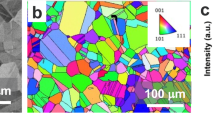Abstract
THE observed corrosion potential at the mouth of a propagating crack in stressed Cu3Au immersed in FeCl3 is as much as 0.1 V, negative relative to that at uncracked parts of the surface1. This suggests that the advancing crack edge is dissolving anodically at an even lower potential. Potential measurements on stress-corroding wires of 18–8 steel in hot magnesium chloride solution2,3, where the average corrosion potential during cracking is only about 0.06 V. above the reversible potential, suggest further that the potential at the advancing edges must in fact be very close to the reversible value. This led Hoar and West4 to study the electrochemistry of 18–8 surfaces made to represent, on a macroscopic scale, the yielding material at such edges. Their experiments showed that dissolution of yielding 18–8 proceeds at the reversible potential provided that concentration over-potential is eliminated by flowing electrolyte past the surface at a suitable rate. It may be inferred that the advancing edge of a propagating stress-corrosion crack dissolves continuously into substantially virgin electrolyte, in view of the concomitant yawning.
This is a preview of subscription content, access via your institution
Access options
Subscribe to this journal
Receive 51 print issues and online access
$199.00 per year
only $3.90 per issue
Buy this article
- Purchase on Springer Link
- Instant access to full article PDF
Prices may be subject to local taxes which are calculated during checkout
Similar content being viewed by others
References
Gerischer, H., and Rickert, H., Z. Elektrochem., 46, 681 (1955).
Hoar, T. P., and Hines, J. G., J. Iron and Steel Inst., 182, 124 (1956).
Hoar, T. P., and Hines, J. G., Int. Comm. for Electrochem., Thermodynamics and Kinetics (CITCE) VIII, 1956, 273 (Butterworths, London, 1958).
Hoar, T. P., and West, J. M., Nature, 181, 835 (1958).
Author information
Authors and Affiliations
Rights and permissions
About this article
Cite this article
WEST, J. Flaw of Electrolyte within a Propagating Stress-Corrosion Crack. Nature 185, 92–93 (1960). https://doi.org/10.1038/185092a0
Issue Date:
DOI: https://doi.org/10.1038/185092a0
Comments
By submitting a comment you agree to abide by our Terms and Community Guidelines. If you find something abusive or that does not comply with our terms or guidelines please flag it as inappropriate.



